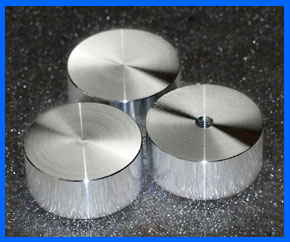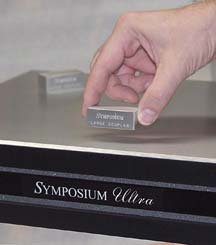Couplers - What They Are and What They Do

Precision Couplers are polished, solid blocks of 7075 aircraft alloy aluminum. A significant improvement over Symposium's previous Large Couplers, Precision Couplers are manufactured to very high tolerances, and feature a threaded, 1/4-20 hole dead center at the top.
That hole The highest quality material and finish Bundles Svelte Speaker Sets, which come in pairs, are sold without couplers, because they should be used with the loudspeaker placed directly onto the Svelte's top surface. Precision Couplers are included with Super Plus and Ultra Platforms, and are optional with Svelte, Svelte Plus, Segue or Segue ISO. Precision Couplers are also available separately. So what IS a "Coupler" - and what do I do with it? Special notes about coupling the component
The Precision Coupler's threaded hole has several uses: it can be used to screw two Precision Couplers together to form a Precision Coupler of 1.625" or 4 cm height with a common setscrew (available from Symposium or from most hardware stores); it can be used to fasten a Precision Coupler to Rollerblock Jr.'s similar 1/4-20 threaded hole; the Precision Coupler directly to components and platforms with a 1/4-20 shaft or hanger bolt; or it can be used as a point receptacle with pointed spikes and cones as a floor protector (making it ideal for use as a Floor Protector with the Isis Rack); or it can be used with ball bearings such as Symposium Grade 10 Tungsten Carbide balls as a fixed point isolator with the ball captured by the hole.
Alloy 7075 is the premium grade of aircraft alloy aluminum, endowed with extreme hardness and strength, and is chosen for its excellent thermal transmission and self-damping characteristics. Each coupler is precision machined here in New Jersey, USA, from a solid bar of 7075 aluminum, and hand finished, preserving nearly perfect flatness on its opposing top and bottom surfaces with very high precision uniformity in thickness. There are two standard varieties: Precision Couplers, and the new Precision Supercouplers.
Many Symposium Platforms and the Isis Rack are either supplied with or can be ordered with Precision Couplers.
 As shown here with an older Large Coupler, the Coupler is a very simple device - and is supplied because it's important to make good mechanical contact to the chassis of your component. The reason for this is that mechanical energy "conducts" through materials analogously to electrical energy - that is, certain types of materials conduct mechanical energy (or vibration) well, and others don't. Examples of materials that conduct energy well are metals; a material that is a poor mechanical energy conductor is rubber. Usually, the denser the material, the better it can conduct energy. For instance, everyone knows that sounds underwater can be "heard" from great distances - greater distances than through air. This is due to water's superior density over air. Metals, because of their relatively high density, and also because of their atomic structure, are able to transfer energy with less loss than compliant materials. Thus, Symposium Couplers are made of a high grade, "aircraft" aluminum alloy, with good transmission characteristics. In all cases, using three or four couplers under your equipment instead of simply placing your equipment down on its original feet provides significant advantages by mechanically connecting the component's chassis to the top layer or "plate" of the Symposium platform. In this way, the Symposium Platform becomes an extension of the component's metal chassis, providing a mechanical ground for energy to be drained off and dissipated without extraneous resonance or reflections back into the component.
As shown here with an older Large Coupler, the Coupler is a very simple device - and is supplied because it's important to make good mechanical contact to the chassis of your component. The reason for this is that mechanical energy "conducts" through materials analogously to electrical energy - that is, certain types of materials conduct mechanical energy (or vibration) well, and others don't. Examples of materials that conduct energy well are metals; a material that is a poor mechanical energy conductor is rubber. Usually, the denser the material, the better it can conduct energy. For instance, everyone knows that sounds underwater can be "heard" from great distances - greater distances than through air. This is due to water's superior density over air. Metals, because of their relatively high density, and also because of their atomic structure, are able to transfer energy with less loss than compliant materials. Thus, Symposium Couplers are made of a high grade, "aircraft" aluminum alloy, with good transmission characteristics. In all cases, using three or four couplers under your equipment instead of simply placing your equipment down on its original feet provides significant advantages by mechanically connecting the component's chassis to the top layer or "plate" of the Symposium platform. In this way, the Symposium Platform becomes an extension of the component's metal chassis, providing a mechanical ground for energy to be drained off and dissipated without extraneous resonance or reflections back into the component.
In general, we've found that the more contact with the chassis of the component, the better the results. Taken to its logical extreme, this would necessitate removing the original feet of the component - something which we don't advocate unless adequate ventilation can be preserved through the chassis, or in cases where ventilation isn't an issue (specifically, in components where the bottom of the chassis is sealed).
What to do if your component's feet are too high
If your component has very large and high feet, more than 13/16 or 0.8125 inch (2 cm), the Precision Couplers will not touch the bottom of the chassis. The easiest solution is another set of Precision Couplers, screwed to the first set to provide a total height of 1 5/8 inches or 4 cm. A "DIY" solution would be a metal "shim" in the form of folded aluminum foil, coins, metal plates or other solid metal with relatively smooth, flat surfaces to increase overall height.
